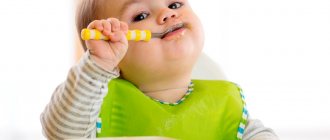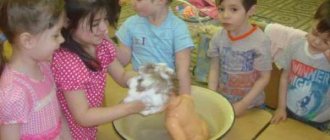Methodological techniques for educating KGN in the preparatory group
When working with children 6–7 years old, the importance of speech techniques increases, since at this age, in the combination of visual and figurative perception, the advantage goes to the latter. And since the children have already completely mastered speech, the creation of images is based precisely on this source of information. At the same time, other methods of interaction - visualization, games, practice - are used no less actively.
In the work on educating KGN, it is important to rationally use the entire arsenal of methodological techniques
Conversation
As already noted, the work of educating KGN with preparatory students is inextricably linked with the formation of positive moral qualities, which, in turn, determines the importance of such a technique as an ethical conversation, in particular, discussion of issues related to the culture of addressing acquaintances and strangers, education habits of keeping track of your things, etc. You can see an example of the topics of conversations on KGN in the preparatory group in the publication of teacher Lomovskaya L.V.
Explanation
In the context of KG education, clarification is used to determine the order of actions when practicing a specific skill. For example, the process of sewing on a button can be described as follows: “We pull the thread into the needle, tighten the ends into a knot, and insert it into the needle bed. We apply the button to the item in the place where it came off. Take a needle and thread and pull the buttons through the hole from the inside out to the face. We make a stitch by passing the needle into the adjacent hole and return it inside out. We repeat the stitches.”
This is interesting. The explanation of practical activities related to CGN is often in the nature of a motivational device that encourages mastering a particular skill: sewing on a button, washing a handkerchief, etc.
Puzzles
Many preschool teachers call this technique a win-win motivation: on the one hand, rhymes attract the attention of kids - everyone wants to distinguish themselves and guess, and on the other hand, they set them up for further development of the topic. These techniques usually begin the consideration of the topic on KGN.
Read also: DIY games for kindergarten
For example, in my practice, when considering the topic “Water, Soap, Towel,” dedicated to developing the ability to soap your hands and face, thoroughly rinse off the foam with water and dry yourself, I begin with riddles:
- It can be family, household, bath, It can be fragrant or it doesn’t smell at all, It can be different colors, sizes and shapes of any kind, But it can only be slippery with water! (Soap),
- We can’t go anywhere without it: “neither here nor there,” We all need very clean... (water) for life.
- Long path, Two embroidered ends, Soft and clean After washing, it will dry me out. (Towel).
The answers to riddles can be specific practical actions of children
Reading, poems
These two techniques can be used successfully either separately or in combination. And in both cases, mainly for motivation. In the first case, an adult or trained children recite poems before practical mastery of the skill. In my work, I use this option in the form of excerpts from “Moidodyr” by K. Chukovsky, which children tell before repeating the order of folding things in the locker and the importance of cleanliness of bed linen.
Reading is practiced in two forms: either the children themselves read texts relevant to the topic, or an adult does it. Of course, the first option is more effective, since it allows children to better understand the essence of the work and also develops an important skill that determines the level of readiness of children for school. But since it is still difficult for children 6–7 years old to read entire poems or prose works, the texts should be divided into meaningful passages. For example, O. Grigoriev’s poem “Jam” can be read in two lines:
- Sergei has no patience, he eats jam with his hands. Seryozha’s fingers stuck together, his shirt grew to his skin. You can’t take your feet off the floor, You can’t take your hands off your feet. Elbows and knees stuck together, Ears stuck together with jam. A pathetic sob is heard - Sergei stuck to himself.
After which, in a conversation, the kids discuss the main idea of the rhyme: in order not to find yourself in Sergei’s situation, you must not forget about the culture of eating.
Reading also helps to attract children's attention to the topic at hand.
Visibility
To educate KGN from this group of techniques, the teacher uses:
- pictures (and not only to accompany the explanation, illustration of each stage of practicing a skill, but also as a demonstration of the stages “before” and “after”, for example, the hero of “Dunno in the Sunny City” N. Nosov Pachkuli Pestrenky before washing and after as a way to awaken kids’ curiosity about what helped him transform like that),
- attributes (kids need to be introduced to different forms of personal hygiene products - solid and liquid soap, a regular and electric toothbrush, washcloths of different shapes, etc., so that in the future they will not have misunderstandings regarding the use of soap in the form of candy or a toothbrush with a cap in in the form of a toy),
- demonstration (any skill - using a fork, a napkin, tidying up a cabinet, changing bed linen, etc. - requires a presentation by a teacher),
- demonstration (if in younger groups this technique in the form of cartoons directly explained the essence of a particular skill, then in older preschool age video materials can be used as motivation for a subsequent conversation on the topic).
Games
The game form of work does not lose its relevance in the preparatory group. In the aspect of education, KGN are used:
- outdoor games (usually in the form of competitions “Who can make the bed better”, “Who can perform hygiene procedures faster after returning from a walk”, etc.),
- theatrical games (this technique is indispensable when practicing table manners, when children in role-playing games appear as cafe visitors, guests of the king),
The work of educating KGN combines routine aspects with skills development
- didactic games that allow you to reinforce the order of performing a particular hygiene procedure.
This is interesting. Games can be used as an element of motivation before direct productive activities.
Table: examples of didactic games in KGN classes in the preparatory group
| Name (equipment) | Goals | Progress of the game |
| “Let's dress Masha for a walk” (cardboard doll Masha and a set of cards depicting clothing items for different seasons). |
| Children lay out in front of Masha the items of clothing necessary for a walk in the season or certain weather indicated by the teacher. |
| “Cultivating good habits” (a cube with an illustration of hygiene procedures). |
| Children take turns throwing the dice and describing the order of the procedure. |
| “Hygiene rules” (game reel with an arrow and pictures illustrating hygiene products). | Summarize knowledge about the importance of observing personal hygiene rules. | The driver rotates the drum, and the guys take turns commenting on those hygiene products that the arrow points to (what they are needed for, how to store them, how to use them). Another version of the game: the teacher asks to name all the body care products (face, hair). |
Read also: Breathing exercises in the first and second junior groups of kindergarten: card index and methodology
Photo gallery: equipment for didactic games for educating KGN
The game Let's dress the doll Masha for a walk can be played in the reverse order, that is, undress after the walk
In the game Developing Good Habits, children, among other things, develop monologue speech
For each correct answer in the game Rules of Hygiene, the child receives a point.
Practical techniques
This is the actual implementation by children of CGN in life, as well as:
- experimental activity (for example, to prove that there are stains that cannot be wiped off, but only washed off, children draw a small spot on their hand with a ballpoint pen, then try to erase it, but only stretch the blot, and go to the washbasins, where they wash off the ink with soap and water ),
- creative tasks (drawings, crafts, applications) on the topic.
Photo gallery: drawings by children of the preparatory group on the topic of educating KGN
Images of drawings can be invented together with parents
In the drawings, the guys can depict the order of performing a specific KGN
Drawings on the topic of healthy lifestyle can be general in nature



